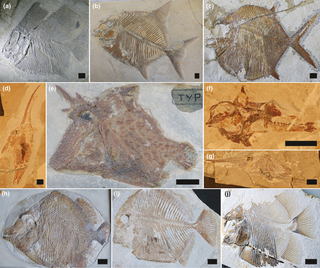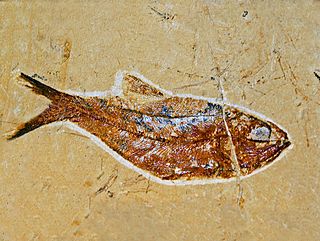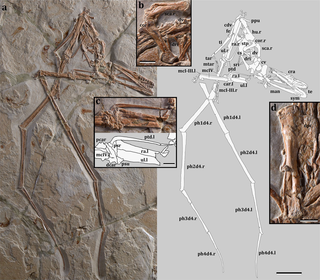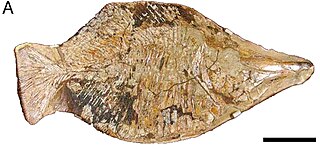
Pycnodus is an extinct genus of ray-finned fish from the Eocene period. It is wastebasket taxon, although many fossils from Jurassic or Cretaceous are assigned to this genus, only Eocene species, P. apodus is valid. As its name suggests, it is the type genus of Pycnodontiformes.
Paleontology or palaeontology is the study of prehistoric life forms on Earth through the examination of plant and animal fossils. This includes the study of body fossils, tracks (ichnites), burrows, cast-off parts, fossilised feces (coprolites), palynomorphs and chemical residues. Because humans have encountered fossils for millennia, paleontology has a long history both before and after becoming formalized as a science. This article records significant discoveries and events related to paleontology that occurred or were published in the year 2005.
Paleontology or palaeontology is the study of prehistoric life forms on Earth through the examination of plant and animal fossils. This includes the study of body fossils, tracks (ichnites), burrows, cast-off parts, fossilised feces (coprolites), palynomorphs and chemical residues. Because humans have encountered fossils for millennia, paleontology has a long history both before and after becoming formalized as a science. This article records significant discoveries and events related to paleontology that occurred or were published in the year 2007.

Paleontology or palaeontology is the study of prehistoric life forms on Earth through the examination of plant and animal fossils. This includes the study of body fossils, tracks (ichnites), burrows, cast-off parts, fossilised feces (coprolites), palynomorphs and chemical residues. Because humans have encountered fossils for millennia, paleontology has a long history both before and after becoming formalized as a science. This article records significant discoveries and events related to paleontology that occurred or were published in the year 2008.

Pycnodontiformes is an extinct order of primarily marine bony fish. The group first appeared during the Late Triassic and disappeared during the Eocene. The group has been found in rock formations in Africa, Asia, Europe, North and South America. They were small to middle-sized fish, generally with laterally-compressed deep bodies, some with almost circular outlines, adapted for manuverability in reef-like environments, though the group was morphologically diverse. Most, but not all members of the groups had jaws with round and flattened teeth, well adapted to crush food items (durophagy), such as echinoderms, crustaceans and molluscs. Some pyncodontiformes developed piranha like teeth used for eating flesh. Most species inhabited shallow marine reef environments, while a handful of species lived in freshwater or brackish conditions. While rare during the Triassic and Early-Middle Jurassic, Pycnodontiformes became abundant and diverse during the Late Jurassic, exhibiting a high but relatively static diversity during the Early Cretaceous. At the beginning of the Late Cretaceous they reached their apex of morphological and species diversity, after which they began to gradually decline, with a more sudden decline at the end of the Cretaceous due to the collapse of reef ecosystems, finally becoming extinct during the Eocene. They are considered to belong to the Neopterygii, but their relationship to other members of that group is uncertain.
The Toolebuc Formation is a geological formation that extends from Queensland across South Australia and the Northern Territory in Australia, whose strata date back to the Albian stage of the Early Cretaceous. Dinosaurs, pterosaurs, plesiosaurs, ichthyosaurs, protostegid turtles, sharks, chimaeroids and bony fish remains are among the fossils that have been recovered from the formation.

The Woodbine Group is a geological formation in east Texas whose strata date back to the Early to Middle Cenomanian age of the Late Cretaceous. It is the producing formation of the giant East Texas Oil Field from which over 5.42 billion barrels of oil have been produced. The Woodbine overlies the Maness Shale, Buda Limestone, or older rocks, and underlies the Eagle Ford Group or Austin Chalk. In outcrop the Woodbine Group has been subdivided into the Lewisville Sandstone, Dexter Sandstone, and/or Pepper Shale formations. Thin-bedded sands of the Woodbine and Eagle Ford are collectively referred to as the "Eaglebine" oil and gas play in the southwestern portion of the East Texas region.

The Aguja Formation is a geological formation in North America, exposed in Texas, United States and Chihuahua and Coahuila in Mexico, whose strata date back to the Late Cretaceous. Dinosaur remains are among the fossils that have been recovered from the formation. Fossil palms have also been unearthed here.

The Kem Kem Group is a geological group in the Kem Kem region of eastern Morocco, whose strata date back to the Cenomanian stage of the Late Cretaceous. Its strata are subdivided into two geological formations, with the lower Ifezouane Formation and the upper Aoufous Formation, with the Gara Sbaa Formation and Douira Formation used in the southern Tafilalt region. It is exposed on an escarpment along the Algeria–Morocco border.
Spathiurus is an extinct genus of prehistoric ray-finned fish that lived during the Cenomanian in the Sannine Formation of Lebanon.

Hemiphlebiidae is a family of damselflies. It contains only one extant species, the ancient greenling, native to Southern Australia and Tasmania. The fossil record of the group extends back to the Late Jurassic, making them the oldest known crown group damselflies.

The Oulad Abdoun Basin is a phosphate sedimentary basin located in Morocco, near the city of Khouribga. It is the largest in Morocco, comprising 44% of Morocco's phosphate reserves, and at least 26.8 billion tons of phosphate. It is also known as an important site for vertebrate fossils, with deposits ranging from the Late Cretaceous (Cenomanian-Turonian) to the Eocene epoch (Ypresian), a period of about 25 million years.

Armigatus is an extinct genus of clupeomorph fishes belonging to the order Ellimmichthyiformes. These fishes lived in the Cretaceous ; their fossil remains have been found in Mexico, Croatia, the Middle East and North Africa, suggesting the genus ranged across the Tethys Sea.

Mimodactylus is a genus of istiodactyliform pterosaur that lived in what is now Lebanon during the Late Cretaceous, 95 million years ago. The only known specimen was discovered in a limestone quarry near the town of Hjoula. The owner of the quarry allowed the specimen to be prepared and scientifically described by an international team of researchers, and when it was eventually sold, the buyer donated it to the MIM Museum in Beirut. In 2019, the researchers named the new genus and species Mimodactylus libanensis; the generic name refers to the MIM Museum, combined with the Greek word daktylos for "digit", and the specific name refers to Lebanon. The well-preserved holotype specimen is the first complete pterosaur from the Afro-Arabian continent, and the third pterosaur fossil known from Lebanon.
Acutalamna is an extinct genus of mackerel shark from the Cretaceous period. It contains a singular species, A. karsteni. The type locality is the La Luna formation of Venezuela, but teeth have been found in France, Peru, Ecuador, and Lithuania. It is possible these teeth represent new species within this genus. Teeth included in this genus were originally attributed to "Priscusurus adruptodontus". The holotype and some of type series of this species were found to be indeterminate Squalicorax teeth, thus rendering it a nomen dubium. Other teeth in the type series of "P. adruptodontus" are indeterminate members of Acutalamna. It bears resemblance to both Anacoracids and Cretoxyrhinids, but has yet to be confidently ascribed to any family.

Mimarachnidae is an extinct family of planthoppers known from the Cretaceous period. Their name is derived from spots on the wings of the first described genera, Mimarachne and Saltissus, being suggestive of spider mimicry, but these characters are not distinctive for the family as a whole. The family is characterised by "simplified venation and setigerous metatibial pecten and hind leg armature". as well as "rounded anterior margin of pronotum, double carination of pronotum and mesonotum"
Yuripopovinidae is an extinct family of Coreoidea Hemipteran true bugs. Member species are known from the Early Cretaceous and early Late Cretaceous of Asia and northern Gondwana. Among the distinguishing characters are "the hemelytral costal vein apically much thickened and pterostigma-like, the corium with two large cells separated by one longitudinal straight vein." Dehiscensicoridae, described from the Yixian Formation of China has been deemed a junior synonym of Yuripopovinidae per Du et al. (2019). The family was named after Russian paleoentomologist Yuri Alexandrovich Popov.
This list of fossil fish research presented in 2021 is a list of new taxa of jawless vertebrates, placoderms, acanthodians, fossil cartilaginous fishes, bony fishes, and other fishes that were described during the year, as well as other significant discoveries and events related to paleoichthyology that occurred in 2021.

Iemanja is a genus of pycnodontiform fish from the Early Cretaceous, described from Romualdo Member of Santana Group. This genus is known from only one species, I. palma. This fish is named after Yemọja, water spirit in Brazilian mythology. With length up to 60 cm (24 in), it is characterized by long snout that is probably used to feed from crevices of reef habitats.



















